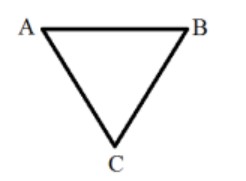Three thin rods of mass m and length a each are joined to form a triangle ABC in vertical plane. The triangle is pivoted at the vertex A such that it can rotate in the vertical plane. It is released from rest when the side AB is horizontal as shown. As the triangle rotates, the maximum velocity of the vertex B, VMAX , is given by:
Three thin rods of mass m and length a each are joined to form a triangle ABC in vertical plane. The triangle is pivoted at the vertex A such that it can rotate in the vertical plane. It is released from rest when the side AB is horizontal as shown. As the triangle rotates, the maximum velocity of the vertex B, VMAX , is given by:
Option 1 -
v²MAX = 4ga/√3
Option 2 -
v²MAX = √3ga
Option 3 -
v²MAX = 2ga/√3
Option 4 -
v²MAX = ga/√3
-
1 Answer
-
Correct Option - 3
Detailed Solution:Using parallel axis theorem for the side BC, the moment of inertia of the triangle about an axis passing through A and perpendicular to the plane of the triangle,
I? = 2 [ (1/3)ma²] + [ (1/12)ma² + m (√3a/2)²] = (3/2)ma²
If the angular velocity of the triangle at any instant is ω, the velocity of the vertex B at that instant is aω
Therefore, the velocity of B is maximum at the instant the angular velocity is maximum, i.e. when the side BC becomes horizontal
Let the angular velocity at this instant be ω?
Then, by conservation of energy
Gain in kinetic energy = Loss in potential energy
(1/2)I? &ome...more
Taking an Exam? Selecting a College?
Get authentic answers from experts, students and alumni that you won't find anywhere else
Sign Up on ShikshaOn Shiksha, get access to
- 66k Colleges
- 1.2k Exams
- 680k Reviews
- 1800k Answers

